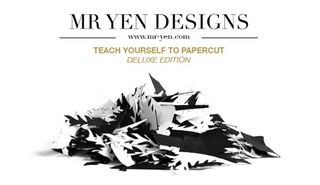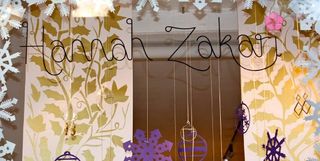Learn the art of papercut with this new ebook
Top papercut artist Mr Yen reveals the tricks of creating beautiful and intricate papercut art in this brand new ebook. We find out more.
We love paper art at Creative Bloq, and we especially love impressive papercut work, particularly when it straddles the boundaries between normal and 3D art.
If you've ever fancied trying it for yourself but you've never really known where to start, you're in luck. Jonathan Chapman, also known as Mr Yen, has been honing his papercut skills for the past five years and has distilled his wisdom into 'Teach Yourself to Papercut', an ebook that'll tell you everything you need to know about creating your own intricate and beautiful papercut art. We caught up with Jonathan for a quick chat about the secrets of paper cutting.

How long did it take you to develop your paper cutting skills?
I started working on papercuts in 2009, so it's been six years that I've been developing my paper cut skills. To develop my skills I started slowly by just experimenting with regular printer paper, a scalpel and my imagination, then I moved onto creating templates that I could print out and use to create a final design - which is still how I create my hand cut designs today. When I first started paper cutting, I would actively develop my skills by practicing daily and constantly experimenting with how to create templates. I would quickly create a template, roughly cut it to see if it worked out and then go back and adjust anything before creating a final design.
What's the hardest thing about paper cutting?
At first, the hardest thing was trying to cut for a long period of time as I didn't really know how to hold the scalpel or which was the best to cut a design. Once I experimented with different tools, papers and techniques, the hardest thing now is definitely remembering to stop and take a break! When I teach my live paper cutting workshops, people don't want to take a break and the room is silent with everyone concentrating so much. I think paper cutting is such a relaxing thing to do and it does get quite addictive - especially once you get the satisfaction of completing a full papercut design.
What's the most important piece of equipment?
Paper! The type you use is important too as using something like a recycled or handmade paper can have fibres in it which could drag on the blade when cutting. This can rip and damage a design and smooth paper is so much easier to cut. You can use lots of different tools to cut paper, and different paper cut artists use different types of scalpels, blades or scissors...but you always need paper.

What are you working on at the moment?
As I've hand cut all of my designs for five years, the next step forward for me to keep up with demand, was to invest in a laser cutting machine. This investment also opens up so many avenues and directions to take my designs that I'm now focusing on creating laser cut wedding stationery. I'm working on finishing my first five ranges that should be available within a few weeks, and I'm already taking on completely custom orders for wedding stationery.

Mr Yen's 'Teach Yourself to Papercut's is available now in two versions. The normal edition features costs £8 and features three mini tutorials, one full tutorial, 19 pages of tips and tricks to create perfect papercuts and four printable templates. The £10 deluxe edition offers everything the normal version has to offer, plus an extra final template to cut, four ideas on how to use papercuts for gift wrapping, four clever ways to frame your newly finished pieces and a page of resources for all things papercut related. Find out more over at Mr Yen's site.
Get the Creative Bloq Newsletter
Daily design news, reviews, how-tos and more, as picked by the editors.

Thank you for reading 5 articles this month* Join now for unlimited access
Enjoy your first month for just £1 / $1 / €1
*Read 5 free articles per month without a subscription

Join now for unlimited access
Try first month for just £1 / $1 / €1

Jim McCauley is a writer, performer and cat-wrangler who started writing professionally way back in 1995 on PC Format magazine, and has been covering technology-related subjects ever since, whether it's hardware, software or videogames. A chance call in 2005 led to Jim taking charge of Computer Arts' website and developing an interest in the world of graphic design, and eventually led to a move over to the freshly-launched Creative Bloq in 2012. Jim now works as a freelance writer for sites including Creative Bloq, T3 and PetsRadar, specialising in design, technology, wellness and cats, while doing the occasional pantomime and street performance in Bath and designing posters for a local drama group on the side.